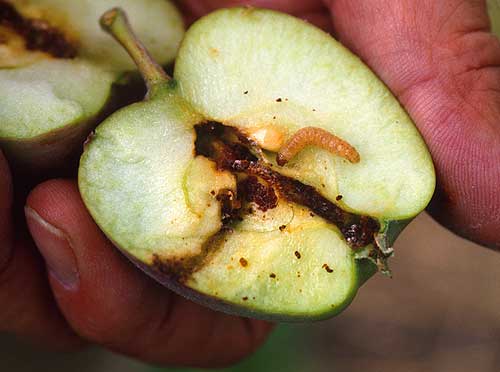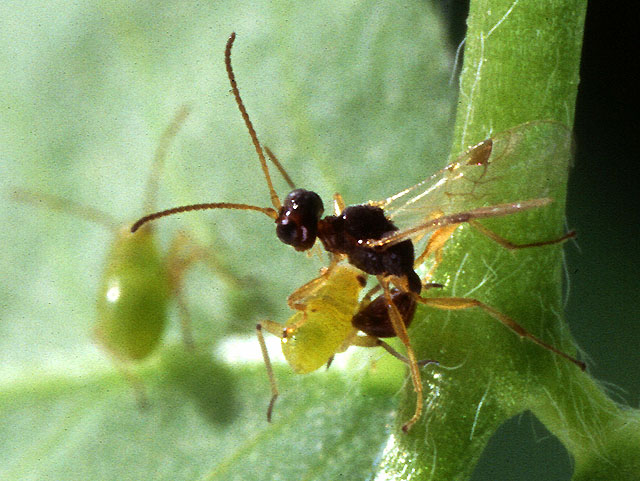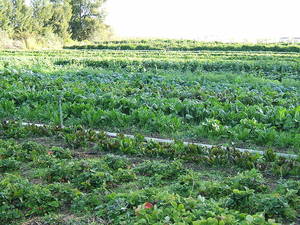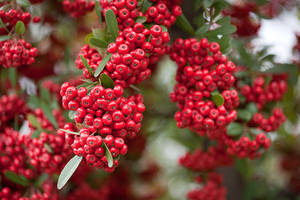Biodynamic pest control on organic farms
Interview with
Helen - Organic farming may not necessarily produce the yield we need to feed the world in future years, but it is booming business, it's increasingly popular and they go about - organic farms go about dealing with the same pest that conventional farmers face but in a different way. We sent Ben Valsler let meet Professor Jane Memmott at Bristol University to find out more.
 Ben - How do organic farms deal with pests? Conventional farmers use pesticides to kill them off, but organic farming relies on the natural predators present acting as bio-control agents to kill off the pests. This is known as Biodynamic pest control, and it's a major part of organic farming, which limits or excludes both pesticides and synthetic fertilizers, with the grand aim of improve the health of soils and ecosystems. Biodynamic pest control relies on having high biodiversity - a wide variety of plants, insects and animals in the ecosystem.
Ben - How do organic farms deal with pests? Conventional farmers use pesticides to kill them off, but organic farming relies on the natural predators present acting as bio-control agents to kill off the pests. This is known as Biodynamic pest control, and it's a major part of organic farming, which limits or excludes both pesticides and synthetic fertilizers, with the grand aim of improve the health of soils and ecosystems. Biodynamic pest control relies on having high biodiversity - a wide variety of plants, insects and animals in the ecosystem.
To see if biodynamic pest control really works, Professor Jane Memmot at the University of Bristol, found 40 farms to compare - 20 organic and 20 conventional. To get a real understanding of what's going on, Professor Memmott's team were looking at the useful roles that organisms play, such as pollination or pest control, also known as 'Ecosystem services'...
Jane - We wanted to look at the scale of the whole farm, and we also wanted to look at interactions between species, because ecosystem services, all of them, are about interaction between species. Whether it's a caterpillar pest and its bio-control agent, whether it's between a flower and a bee that leads to an apple or a tomato or whatever, they all involve interactions. So rather than just counting species, which is what previous studies have done; they count how many birds or how many beetles or how many spiders are on organic and conventional farms and compare the two, we wanted to put together food webs.
 Ben - In an ambitious project, Jane and Bristol University undergraduates set about mapping and sampling all 40 farms -observing all of the plants, predators, prey and pest species present. They payed particular attention to parasitoids - organisms which spend a portion of their life parasitizing another. As gruesome as this sounds, parasitoids that target caterpillars are essential to pest control...
Ben - In an ambitious project, Jane and Bristol University undergraduates set about mapping and sampling all 40 farms -observing all of the plants, predators, prey and pest species present. They payed particular attention to parasitoids - organisms which spend a portion of their life parasitizing another. As gruesome as this sounds, parasitoids that target caterpillars are essential to pest control...
Jane - So every month a team of people would go through the farm and sample transects in each of the different habitats. To do that you walk through or go through on your hands and knees, through the habitat, and you're collecting all the caterpillars and all the leaf miners in that habitat, and you're counting all the plants that are in that habitat. You then take your caterpillars back to the lab and you either get a moth or you get a parasitoid out of them. So that information can then be used to join up all of the species into food webs; who eats who, which caterpillars eat which plants and which parasitoids eat which caterpillars. And we've got one of those for each farm.
Ben - The food webs predictably showed that there was slightly more biodiversity on the organic farms than on conventional farms, but food webs alone cannot tell you how effective an ecosystem is at tackling pests...
Jane - So what our prediction was next was that the organic farms would provide better biological pest control. You've got more species of parasitoid on there, more semi-natural habitat, so they should give you better pest control. Indeed, the whole ethos of organic farming is that one of the reasons they don't get as many pests is because they've got all these beneficial insects that eat all the pests.
 So what we did next - it's actually my favourite bit, it's the clever bit - was that having got the networks we then decided to manipulate them in some way. Now what we wanted to do, the ideal experiment, is to find a pest, a new pest, and put it on all farms and see if they're better controlled on the organic farms. But you can straight away see that that's not going to work. It's ethically, morally suspect, you just can't do it - the farmers would never let you back again! So you can't do that so what we did instead was we found a surrogate pest, we found something that was pest like but would not appear on the farms naturally, and we could use as a kind of surrogate pest to ask what would happen if a new species of insect came in. And the particular insect we used was a thing called the Pyracantha leaf miner.
So what we did next - it's actually my favourite bit, it's the clever bit - was that having got the networks we then decided to manipulate them in some way. Now what we wanted to do, the ideal experiment, is to find a pest, a new pest, and put it on all farms and see if they're better controlled on the organic farms. But you can straight away see that that's not going to work. It's ethically, morally suspect, you just can't do it - the farmers would never let you back again! So you can't do that so what we did instead was we found a surrogate pest, we found something that was pest like but would not appear on the farms naturally, and we could use as a kind of surrogate pest to ask what would happen if a new species of insect came in. And the particular insect we used was a thing called the Pyracantha leaf miner.
Ben - As its name suggests, the pyracantha leaf miner is a pest that lives inside the leaves of the pyracantha plant - a hardy, prickly plant that wouldn't normally be found on a farm. By planting 40 pyracantha bushed on each farm and introducing the leaf miners, they can act as a surrogate pest to show the level of natural pest control.
Jane - And what we found really surprised us, because we found that for this particular species, the pest control was no better on the organic farms than on the conventional farms. So there was no difference whatsoever in the number of them killed. So this kind of made us scratch our heads a bit. And what we did then was, because we have these networks for each farm, we went back to our networks and asked, well, how many parasitoids are there that would probably attack this species? And actually it turns out that when you retrospectively predict what could attack it, there really aren't more species of parasitoid on organic farms than conventional farms.
 Ben - Using the same data, they were able to predict that just three of more than thirty families of insects would be better controlled on the organic farms - Professor Memmott now plans to introduce surrogate pests from each of these families, and see if biodynamic pest control really does work.
Ben - Using the same data, they were able to predict that just three of more than thirty families of insects would be better controlled on the organic farms - Professor Memmott now plans to introduce surrogate pests from each of these families, and see if biodynamic pest control really does work.
So what does this mean for organic farming?
Jane - The conventional farms all have lots of semi-natural habitat on them, so they are kind of getting this pest control for free and they don't necessarily realise that it's there. So it's not just having more biodiversity, it's actually having the right sort of biodiversity that's really important. Conventional farms can actually get an awful lot of the biodiversity gains of organic farms without going wholesale organic. We're never going to have more than about 5-10% or farms organic in the UK, I don't think, ever, so that 90% of other farms, if they can make small changes in what they do that could actually have a really big effect on biodiversity nationwide. And if they can take some of the things that really work from the organic farms which don't involve wholesale conversion to organic-ness, then that could reap huge biodiversity gains across the country.
Ben - So adopting certain aspects of organic farms - for example growing healthy hedgerows and areas of semi-natural habitat, or reducing reliance on pesticides - could see conventional farms bursting with biodiversity, and naturally protected from pests.
Jane - But little changes from the great majority of conventional farmers, rather than having another 2% of organic farms say, could make the most enormous difference.
Chris - So you don't need to be totally organic. Just a bit organic would do. That was Professor Jane Memmott, she's at the University of Bristol and she was talking to our own Ben Valsler.
- Previous Transgenic Plants
- Next Seawater Greenhouses









Comments
Add a comment